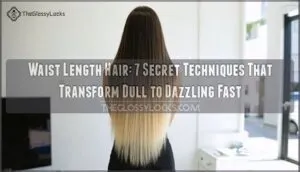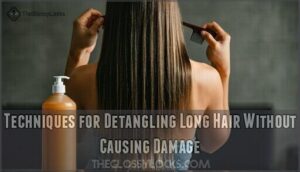This site is supported by our readers. We may earn a commission, at no cost to you, if you purchase through links.
 Maintaining waist length hair requires dedication and proper technique.
Maintaining waist length hair requires dedication and proper technique.
You’ll need patience—hair grows about ½ inch monthly—and consistent care to prevent breakage.
Wash your hair 2-3 times weekly using sulfate-free products, and always detangle gently from ends to roots.
Protective styles like braids minimize friction damage, while trimming ends every 8-12 weeks prevents splits from traveling upward.
Sleep on a silk pillowcase to reduce nighttime breakage.
Balance your diet with protein, biotin, and omega-3s to strengthen hair from within.
The journey to healthy waist length hair isn’t just about growth—it’s about preserving every inch you’ve earned.
Table Of Contents
- Key Takeaways
- Understanding Hair Growth and Genetics
- Developing a Hair Care Routine
- Detangling and Preventing Breakage
- Hydrating and Nourishing Hair
- Protecting Hair From Damage
- Frequently Asked Questions (FAQs)
- How long is waist length hair?
- What is waist-length hair?
- How to style a waist length hairstyle?
- Can you grow waist-length hair?
- How long does waist-length hair grow?
- How long is a waist-length mane?
- What is considered waist-length hair?
- How rare is waist-length hair?
- How long does it take hair to grow waist length?
- What are the best hairstyles for outdoor activities?
- Conclusion
Key Takeaways
- Detangle gently from the ends to the roots with a wide-tooth comb and use leave-in conditioners to reduce breakage.
- Protect your hair by limiting heat styling, using silk pillowcases, and opting for protective hairstyles.
- Regular trims every 8-12 weeks prevent split ends and preserve length without sacrificing hair growth.
- Maintain a healthy diet with protein, biotin, omega-3s, and plenty of water to strengthen hair from the inside out.
Understanding Hair Growth and Genetics
You’ll release your hair’s natural growth potential when you understand how your genetics influence its growth rate, texture, and maximum length.
Working with your genetic blueprint, rather than against it, lets you create a personalized care routine that transforms your strands from lackluster to lustrous on the journey to waist-length glory.
The Role of Genetics in Hair Growth and Health
The DNA blueprint you’ve inherited substantially influences your hair’s growth rate, texture, and overall health.
Your genetic predisposition affects everything from how quickly your hair grows to how it responds to environmental stressors.
Understanding your hair’s genetic makeup helps you develop targeted strategies for reaching that coveted waist-length goal.
- Hair growth phases are genetically programmed, with some people naturally experiencing longer anagen (growth) phases that allow their hair to grow longer before shedding.
- Hair texture genes determine whether you’re working with straight, wavy, or curly strands—each requiring different care approaches to maximize length retention.
- Scalp health genetics impact oil production and follicle density, directly affecting how many hairs you have and how well-nourished they remain.
While you can’t change your hair loss genes, you can work with your natural growth rate genetics by providing ideal conditions through proper care techniques and hair vitamins.
Nutritional Factors That Influence Hair Growth and Strength
Your genes aren’t the only players in the hair game. What you eat directly fuels your hair growth journey to waist-length glory.
- Protein intake powers keratin production, the fundamental building block of strong strands.
- Vitamin intake prevents deficiencies that stall hair growth and lead to shedding.
- Mineral absorption supports scalp health and activates hair follicle function.
- Hydration effects maintain flexibility and prevent brittle, breakage-prone hair.
Genetic factors also influence hair density, as the number of follicles is genetically determined.
- Experience the thrill of watching your hair grow an inch longer each month
- Feel the pride when friends ask if you’re wearing extensions
- Enjoy the confidence of knowing you’re nourishing your hair from within
- Celebrate breaking free from the cycle of growth plateaus
Developing a Hair Care Routine
You’ll need a consistent hair care routine to transform your waist-length locks from lifeless to luminous.
Your journey to stunning hair starts with gentle products and regular trims that prevent damage while preserving your hard-earned length, which is a complete concept in hair care.
Importance of Regular Trims to Prevent Split Ends
Despite what you might’ve heard, regular trims are your secret weapon for maintaining waist length hair. By removing damaged ends before they split further up the shaft, you’re actually preserving length in the long run.
| Hair Type | Trimming Frequency | Amount to Cut | Benefits |
|---|---|---|---|
| Straight | 8-12 weeks | 1/4 inch | Prevents breakage, maintains evenness |
| Wavy | 10-14 weeks | 1/2 inch | Controls frizz, defines wave pattern |
| Curly | 12-16 weeks | 1/2-3/4 inch | Prevents tangling, maintains shape |
| Coily | 16-20 weeks | 3/4-1 inch | Reduces knots, prevents excessive dryness |
Think of split end prevention as insurance for your length retention strategy. Even minimal trimming (dusting) can dramatically improve hair health without sacrificing those precious inches you’ve grown. Addressing existing hair damage is also essential for overall hair health. Remember, professional stylist advice suggests focusing on quality over quantity—healthy ends ultimately lead to longer, more beautiful waist length hair.
Using Gentle, Non-damaging Hair Care Products and Techniques
The journey to waist-length hair requires gentle allies in your bathroom cabinet.
Switching to sulfate-free shampoos preserves your hair’s natural oils while cleansing effectively.
When styling, embrace air drying whenever possible—your strands will thank you for skipping the heat damage that stunts growth.
Natural oils like jojoba or argan can replace heavy commercial products, nourishing without weighing down your locks.
At bedtime, silk pillowcases become your hair’s best friend, reducing friction that causes breakage and frizz.
During the day, opt for low-tension styles that won’t stress your hairline or snap delicate strands.
Scrunchies and fabric-covered elastics prevent the dreaded "ponytail dent" while securing your style.
Remember, hair care products don’t need to be expensive to be effective—consistency in your hair damage prevention routine matters more than price tags.
A key step involves understanding your hair’s porosity to select the right products.
Detangling and Preventing Breakage
You’ll prevent countless broken strands and maintain your waist-length glory by mastering proper detangling techniques, which start at the ends and work upward with a wide-tooth comb.
Your hair’s strength depends on gentle handling during its most vulnerable moments, especially when wet or tangled after sleep, and this is crucial for maintaining waist-length glory.
Techniques for Detangling Long Hair Without Causing Damage
The art of detangling waist-length hair requires patience and proper technique to prevent breakage and maintain your luscious locks.
- Start with a wide-tooth comb at the ends and work your way up, never pulling forcefully through knots
- Apply a leave-in conditioner or detangling spray before brushing to create slip and reduce friction
- Use specialized detangling tools like Tangle Teezers or Wet Brushes designed specifically for minimizing breakage
- Section your hair before detangling to manage smaller, more controllable portions
- Incorporate gentle brushing into your daily routine to prevent severe tangling from developing
For extremely knotted areas, apply extra product and use your fingers first. A great way to start is with quality hair products designed to help. Remember, rushing the detangling process often leads to more damage and hair loss than taking your time with proper techniques and tools.
The key to successful detangling is to work slowly and gently, using the right tools and products to minimize breakage and prevent hair loss. By following these steps and being mindful of your hair’s needs, you can keep your locks healthy and looking their best.
Tips for Reducing Knots and Tangles During Daily Activities and Sleep
Tangle-free tresses are essential for maintaining your waist-length hair during daily activities and sleep. Preventing knots saves both your hair and sanity.
- Nighttime Braiding: Secure your locks in a loose braid before bed to minimize friction and movement that causes tangles.
- Silk Bonnets: Wrap your hair in a silk bonnet or use silk pillowcases to reduce friction that creates knots while you sleep.
- Gentle Brushing: Use wide-tooth combs for hair detangling, starting from ends and working upward to prevent breakage.
Hydration importance can’t be overstated—well-moisturized hair resists tangling. Using a sulfate-free shampoo can also help prevent tangles.
Protective hairstyles during workouts also keep those beautiful strands knot-free.
Hydrating and Nourishing Hair
You’ll need to supply your waist-length locks with intense moisture and nutrients to transform brittle strands into silky, enviable tresses.
Your long hair demands more hydration than shorter styles because natural oils can’t travel the entire length, leaving ends dry and prone to breakage, which requires intense moisture to repair.
Selecting The Right Hydration Treatments for Your Hair Type
Now that your tangles are under control, let’s focus on properly hydrating that beautiful waist-length mane.
Your hair type determines which moisture treatments will work best. Fine hair loves lightweight hydration from hyaluronic acid, while thicker strands crave richer ingredients like shea butter.
Check your hair porosity before selecting products—it’ll tell you how frequently you need treatment. DIY masks can work wonders between salon visits, and smart product overlap prevents moisture overload.
Consistent use of quality products can reduce hair breakage substantially, which is crucial for maintaining healthy and strong hair, and it helps in properly hydrating your hair, leading to a beautiful and healthy-looking waist-length mane.
The Impact of Diet and Nutrition on Hair Hydration and Health
Behind every strand of waist-length hair lies a fundamental foundation: what you eat directly impacts your hair’s hydration and health.
Healthy hair starts from within—nourish your strands with hydration, protein, and vitamins for strength and shine that lasts.
- Dietary Hydration: Your scalp craves proper hydration from within. Drink at least 8 glasses of water daily to maintain moisture levels that keep hair supple and prevent brittleness.
- Protein Intake: Since hair is 91% protein, consuming lean meats, eggs, and legumes builds resilient strands that resist breakage on their journey to waist length.
- Healthy Fats: Omega-3s from salmon, avocados, and nuts deliver natural moisture to your scalp, preventing dryness that leads to lackluster locks.
- Vitamin Deficiencies: Low levels of B vitamins, zinc, and iron can stunt growth and cause excessive shedding—hair supplements can help fill nutritional gaps when your diet falls short.
Protecting Hair From Damage
You’ll need to shield your waist-length locks from the daily assault of heat tools, chemicals, and environmental stressors that can transform your crowning glory into a frizzy mess.
Your hair’s health depends on minimizing damage through protective measures like heat-free styling alternatives, quality protectant products, and nighttime care routines that preserve length while you sleep.
Avoiding Excessive Heat Styling and Chemical Treatments
Heat tools and chemical processes are arch-enemies of waist-length hair.
You’ve hydrated your tresses—now let’s protect that investment. Cut back on heat styling to avoid hair breakage; when you must, apply heat protectants and use your tools on the lowest effective setting.
Your straightener doesn’t need to be volcano-hot to work! Embrace your natural textures and try air drying with styling products instead.
For color, consider chemical alternatives like henna or vegetable-based dyes that won’t compromise hair health. To mitigate heat damage, consider using specialized protective sprays.
Give your hair regular heat holidays—your mermaid-length locks will thank you with shine and strength that no temporary style could match.
Strategies for Minimizing Environmental Damage to Hair
Environmental forces wage a constant battle against your waist-length locks.
To shield your hair from UV damage, apply protective sprays or oils with built-in UV filters before heading outdoors—they’re your hair’s personal bodyguard against sun damage.
When facing urban pollution, consider wearing protective styles like braids or updos that minimize exposure, and don’t forget to detox with clarifying shampoos weekly.
Before swimming, wet your hair with clean water to prevent chlorine or salt absorption, then rinse thoroughly afterward.
Weather effects like wind and humidity can lead to tangles and frizz, so carry a silk scarf for impromptu protection.
Combat product buildup with occasional apple cider vinegar rinses.
Remember, consistent hair protection strategies aren’t just about maintaining length—they’re about preserving your hair’s health and preventing the breakage that can compromise your hard-earned progress.
Frequently Asked Questions (FAQs)
How long is waist length hair?
Waist-length hair typically spans 20 to 28 inches, depending on your height and natural waist location.
Hair type matters too—curly hair needs more actual length compared to straight hair due to shrinkage.
What is waist-length hair?
Waist-length hair cascades down to your natural waist, usually 20-28 inches long, depending on your height.
It’s a beauty statement that demands patience, proper care, and some serious commitment to keep it healthy and stunning.
How to style a waist length hairstyle?
Styling waist-length hair is like shaping flowing fabric—layer it for movement, braid it for elegance, or curl the ends for bounce.
Protective styles like buns or ponytails add flair while keeping tangles at bay.
Can you grow waist-length hair?
You can absolutely grow waist-length hair with patience and care.
Focus on a healthy diet, regular trims to prevent split ends, and gentle handling to avoid breakage.
Consistency and smart products make a big difference!
How long does waist-length hair grow?
Imagine your hair growing like a slow, steady river—about half an inch monthly.
Roughly, it takes 4-5 years for most people to grow hair from their scalp to their waist, depending on care.
How long is a waist-length mane?
A full-length mane that brushes your waist typically measures 20 to 28 inches, depending on your height. Straight hair shows its full glory, while curls need extra length to account for shrinkage.
What is considered waist-length hair?
Waist-length hair reaches your natural waist, where your torso indents when you bend sideways.
Typically it’s 20-28 inches long, but body shape, hair texture, and shrinkage can make the length appear slightly different.
How rare is waist-length hair?
Long locks that land at your waist are rare, not because hair doesn’t grow, but because patience and perseverance often don’t.
It takes years, healthy habits, and skipping scissors — a commitment many abandon early.
How long does it take hair to grow waist length?
Hair grows about 5 inches monthly, so reaching waist length—roughly 20-28 inches—takes 3-5 years.
Factors like genetics, hair care, trims, and overall health can speed up or slow down progress.
Patience helps!
What are the best hairstyles for outdoor activities?
For outdoor activities, braided styles like French braids or fishtails keep hair secure, reduce tangles, and handle wind.
Ponytails or buns are practical, while adding a hat guarantees extra protection from sun and weather.
Conclusion
Achieving waist length hair might feel like climbing a mountain barefoot, but it’s absolutely doable with the right techniques.
Focus on preserving every inch by detangling gently, moisturizing deeply, and trimming split ends regularly.
A silk pillowcase and protective styles work wonders for minimizing damage, while a diet rich in proteins and omega-3s strengthens hair from within.
Consistency is your best friend here—stick to your routine, and your hair will thank you with vibrant, waist-grazing beauty, achieved through protective styles and a commitment to minimizing damage.










